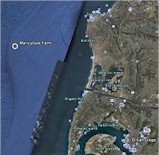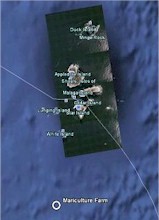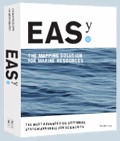Sites Evaluated
The Southern California Bight Test Site
 Previously the AquaModel team prepared and operated a model of a proposed open ocean site to be located about 5 miles (8 km) due west of Mission Beach in San Diego Hubbs-SeaWorld Research Institute. (Please note that this study was done with an earlier version of AquaModel and does not include all the latest enhancements.) To see the details of this study click here.
Previously the AquaModel team prepared and operated a model of a proposed open ocean site to be located about 5 miles (8 km) due west of Mission Beach in San Diego Hubbs-SeaWorld Research Institute. (Please note that this study was done with an earlier version of AquaModel and does not include all the latest enhancements.) To see the details of this study click here.
This was a proposed demonstration project to assess the feasibility of offshore fish farming. The plan is to start with 8 individual 25 meter cages to rear about 1000 metric tons of striped bass (Morone saxatilis), closely monitoring benthic and other effects. Eventually, the farm would be increased to 24 cages and a 3,000 metric ton production.
For the current far field study, a month long simulation of virtual fish farms located in the deep, offshore waters of the Southern California Bight was conducted with a starting biomass of approximately 21,500 metric tons of fish distributed equally throughout eight fish farms positioned from north to south in the San Diego Countercurrent area of the Southern California Bight using local bathymetry and water quality data. This area differs greatly from the Gulf of Maine University of New Hampshire site reported herein because of differing circulation patterns including several persistent eddies, warmer annual water temperature and very low background nitrogen concentrations in comparison.
The University of New Hampshire Open Ocean Aquaculture Site
 The University of New Hampshire has operated an open ocean aquaculture site in the region from late 1999 until 2010. The site is in approximately 55 meters of water and is located 2.6 km south of the Isles of Shoals in the state waters of New Hampshire (USA).
The University of New Hampshire has operated an open ocean aquaculture site in the region from late 1999 until 2010. The site is in approximately 55 meters of water and is located 2.6 km south of the Isles of Shoals in the state waters of New Hampshire (USA).
An extensive number of data sets were acquired from the region and input into AquaModel to calculate the bioenergetics of salmon in a fish farm, the production of solid and dissolved wastes, the transport and fate of the wastes and characteristics of the benthos (aerobic and anaerobic). The program was then used to investigate the dynamic response of the surrounding environment to possible commercial level operations.
Data sets were obtained from both a near-field oceanographic buoy at the The UNH Open Ocean Aquaculture Site and a far-field oceanographic buoy, operated by the The UNH Center for Oceanographic Observation and Analysis.
Click here for a more complete explanation of the data that was used in evaluating this site.


